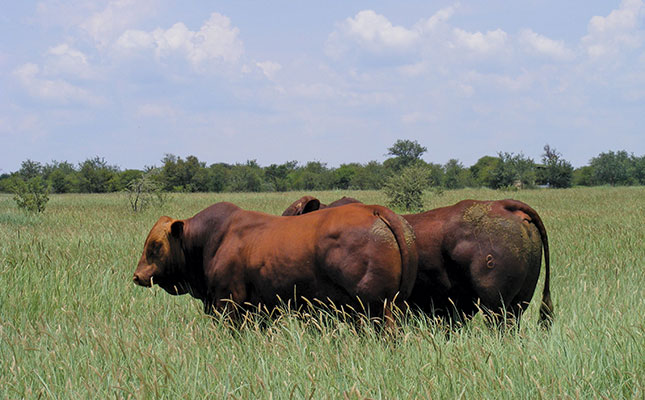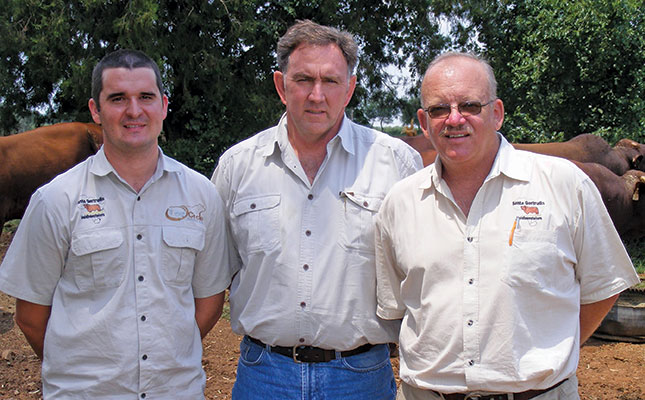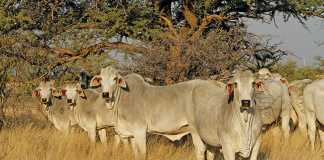
Photo: Annelie Coleman
The first tests in South Africa to evaluate the performance of Santa Gertrudis bulls on the veld have yielded promising results. The tests are being conducted in the North West, near Buhrmansdrift in the Mahikeng district close to the Botswana border.
They were initiated by breeders Jacob van Zyl, Louwrens van Vuuren, Naudé Pienaar, Wimpie Moolman, Paul Doubell and Tiaan Bekker after a brainstorming session some six years ago.
“We asked ourselves why this fine breed found it so difficult to make inroads in commercial beef production,” explains Naudé.
“It has exceptional breeding values not disputed by most cattlemen. Despite this, the notion persists that Santas are mainly destined for the feedlot and don’t perform well under extensive veld conditions.”
A non-selective grazer with a strong walking ability and excellent feed conversion rate, the modern Santa Gertrudis is medium-framed and early maturing, with exceptional muscling.
“The South African Santa has a smooth, deep dark red coat and is ideally suited to extensive veld conditions,” says Naudé. “The average weaning weight is about 230kg at seven months, compared with the national average of 215kg for all beef breeds.”
The first veld tests started in 2009, and the bulls that perform well are marketed under the Veld Santa brand. “We decided to run selected bulls on the veld for at least one winter season and one summer season,” says Louwrens.
“The extended test period enables us to determine the bulls’ performance during four seasons and particularly during winter. The normal period for other veld bull tests is about six months.
“Our bulls’ performance is tested against a Brahman control group run under similar conditions. We decided on the Brahman as our benchmark because it’s known for its excellent performance on the veld.”
Test groups normally consist of 25 to 30 stud Santa Gertrudis bulls and five stud Brahman bulls. Prospective bulls are first screened by the Veld Santa breeders, then by independent Santa Gertrudis adjudicators.
Test bulls are selected for functionality, hardiness and temperament, as well as a superior hindquarter, a good top-line, a short sheath and well-developed testes. Another objective is to identify genetic lines that perform well on veld, so the bulls come from a wide genetic background, including Australian genetics.

Consistency
The bulls are kept under the same conditions every year on the farms of Wimpie Moolman and Paul Doubell. These have sweetveld with a high percentage of blue buffalo grass (Cenchrus ciliaris) and a variety of other grasses such as Smuts finger (Digitaria eriantha) and black-footed signal grass (Brachiaria nigropedata).
Average annual rainfall is about 480mm, but the area suffered from a devastating drought with significantly less rain in 2011, 2012 and 2013. The temperature ranges from the high 30s in summer to below zero in winter.
Bulls receive a daily ration of Meadow or Voermol production lick throughout the year, together with a Cipla Agrimed inoculation and health programme. Two tests are held a year, accommodating two breeding seasons.
The tests start in May and November and independent adjudicators weigh the bulls every month. Optimum growth rate is important in any beef enterprise. In this regard, the Santa Gertrudis is not easily defeated by any other breed, says Wimpie.
“The Santa bull PZ 11 20 achieved an average daily gain (ADG) of 0,911kg in the May 2012/2013 veld test. The Santa Gertrudis’s ADG for the period was 0,745kg, compared with 0,746kg of the Brahmans.
A total of 18 bulls of which 16 were Santas and two Brahman, exceeded the Brahman average in the 2012 test,” he explains.
Altogether, 36 bulls were tested. Four tested above average: PZ 11 20 (22,17% above average) JHM 11 19 0 and PZ 11 006 (both 14,68%)and CBR 11 00 7 (12,71%). The group’s average weight at the start of the test on 3 May 2012 was 247,5kg.
The final average weight 340 days later was 98,3kg. The average ADG over the period was 0,745kg. The bulls’ average age at the end was 598,3 days.
“We’ve learnt a lot from the veld tests,” says Louwrens.
“For example, a bull weaned at seven months and immediately put on the veld suffers weaning shock. It takes such a young bull at least three months to catch up with older bulls. “This is no problem for us, because the Santa’s excellent growth rate is underpinned by a high ADG value. We sell our bulls at 30 to 36 months. The Santa sheds its deciduous teeth later than other breeds do, often as late as 24 months.”
In preparation for a sale, bulls are backgrounded on the veld with a Nutrifeed concentrate. In addition, they are tested for fertility, contagious abortion and TB, and sheath-washed for trichomoniasis and vibriosis.
All are inoculated against Rift Valley fever, anthrax, black quarter and lumpy skin disease, using One Shot Ultra 7 with a booster shot. The bulls receive multi-vitamin injections every three months and an additional vitamin A, D and E injection when green grazing is not available.
Inaugural veld Santa sale
The first Veld Santa sale will be held on 11 April. In this way, the bulls will arrive at their new farms before the onset of winter, making adaptation easier.
It also means that the Veld Santa Group doesn’t compete with other Santa auctions, most of which are held in August and September. Some 25 bulls will be on offer. “An elite heifer sale will form part of the occasion as part of our commitment to make the best quality cattle available to buyers,” says Naudé.
“We’ve decided to offer 27 top stud heifers in lots of three. Prospective buyers will also have the opportunity to bid on the heifer they deem the best of the three. The remaining two will be taken back to their respective farms. This means that only the nine best heifers will be sold.”
He adds that they expect many buyers from Botswana, now that South Africa has regained its FMD-free status.
“We’ve established that the Santa Gertrudis is a top contender among veld-adapted cattle. It’s a highly economical red breed that achieves top meat production per hectare with low inputs under extensive conditions.
“These tests have proved the Santa’s ability to convert grass to beef as an added bonus to all its other well-known attributes. We’ve proved the critics of our breed to be wide of the mark.”
Phone Naudé Pienaar at 082 776 8283 or email [email protected], and Louwrens van Vuuren on 082 718 4305.













